Physical Address
304 North Cardinal St.
Dorchester Center, MA 02124
Physical Address
304 North Cardinal St.
Dorchester Center, MA 02124
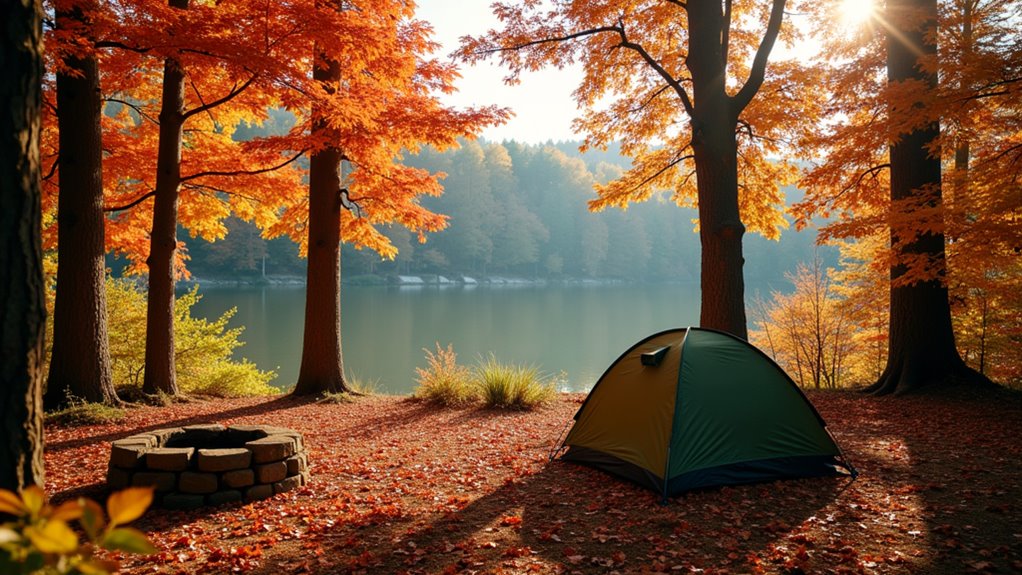
Keen campers can discover the secrets of finding autumn's perfect camping spots, from peak foliage timing to essential weather considerations.
You’ll find that selecting the perfect fall camping destination requires more strategic planning than summer adventures. As autumn’s crisp air settles in and leaves begin their colorful transformation, you’ll need to take into account factors beyond just scenic views. From tracking peak foliage dates to evaluating campground winterization schedules, your ideal destination depends on several key elements. Let’s explore how to pinpoint that sweet spot where comfort, beauty, and practicality converge in your fall camping journey.
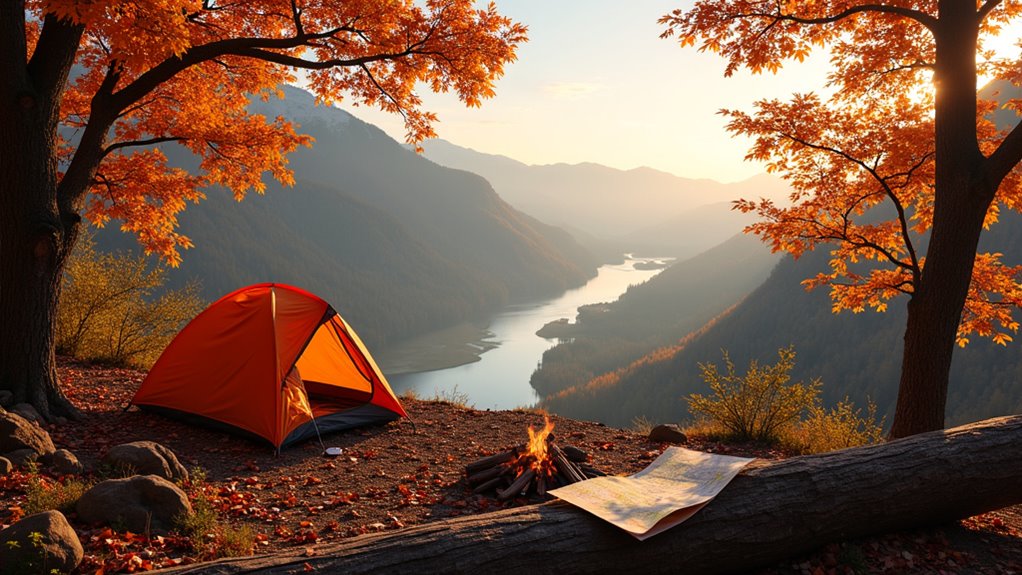
When planning a fall camping trip, understanding peak foliage timing is essential for catching nature’s most vibrant display.
You’ll find that elevation plays an important role, with higher locations above 4,000 feet turning color in early to mid-October, while lower elevations peak later in the season.
To pinpoint the perfect timing, you’re encouraged to utilize interactive fall foliage maps, state park websites, and foliage tracking apps. These tools provide real-time updates and forecasts for specific regions. Don’t forget to check NOAA data and forest service reports for the most accurate predictions.
Consider that northern states and mountainous areas start changing in late September, while southern locations hold off until mid-October through November. You’ll also notice that microclimates, such as areas near lakes or urban centers, can shift peak times by several weeks. For optimal color vibrancy, look for locations that experience warm days and cool nights during the transition period. Plus, modern and creative camper trailers can provide a comfortable and stylish way to enjoy the fall foliage during your camping adventure.
Beyond tracking fall colors, understanding weather patterns will shape your entire camping experience. You should aim to target destinations with daytime temperatures between 50-70°F for maximum comfort during outdoor activities.
Remember that temperatures can swing dramatically, especially in desert and mountain regions. Consider your destination’s geography carefully. Northern locations will cool faster than southern ones, while coastal areas offer more stable temperatures. High-elevation spots might already see snow by early fall. Look for campsites with natural windbreaks like trees and bushes to ensure more comfortable conditions.
Plan wisely – geography shapes your experience. Desert nights freeze while coastal areas stay moderate. Mountains may surprise with early snowfall.
You’ll need to monitor forecasts vigilantly and pack for variable conditions, as nighttime temperatures often dip into the 40s°F. Don’t underestimate the impact of wind chill and humidity on your comfort.
If you’re planning activities like hiking or photography, morning hours are ideal when temperatures are mild and visibility is best.
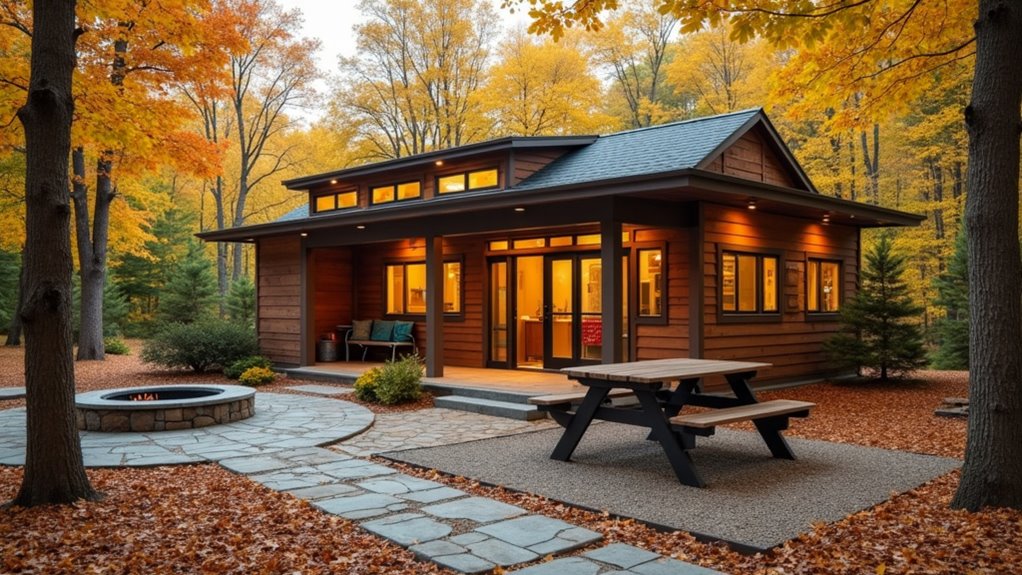
As you evaluate potential campgrounds, understanding their amenities and facility features will greatly impact your comfort and overall experience.
Look for sites offering full hookups if you’re RV camping, as approximately 89% of campgrounds provide these essential connections. For tent campers, check the availability of communal water sources and clean restroom facilities.
You’ll want to confirm the presence of hot showers, laundry facilities, and Wi-Fi if you’re planning an extended stay. With 48% of campers now considering Wi-Fi an essential amenity, many campgrounds have improved their connectivity services. On top of that, Essential RV Camping Tips You Need to Know can provide valuable insights to enhance your RV camping experience.
Consider campgrounds with recreational amenities like hiking trails, sports courts, or water access to enhance your fall activities.
Don’t forget to verify essential safety features such as well-lit common areas and emergency services.
If you’re traveling with pets, search for locations with designated pet areas or fenced spaces, and ascertain the facilities match your accessibility needs.
Since fall triggers heightened wildlife activity, choosing a destination with abundant biodiversity can transform your camping experience into an unforgettable wildlife adventure. National parks like Shenandoah, Acadia, and Zion offer diverse ecosystems where you’ll spot various species preparing for winter.
Fall awakens wildlife across America’s national parks, offering campers front-row seats to nature’s spectacular pre-winter preparations.
The decrease in bugs during fall makes wildlife observation more comfortable and enjoyable for campers.
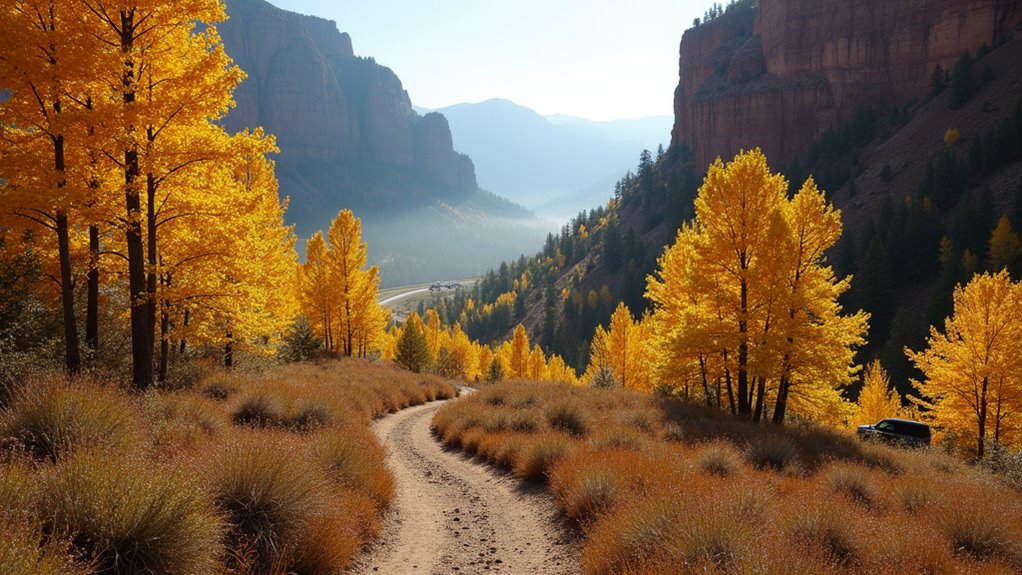
The right combination of trail access and scenic drives can take your fall camping experience to new heights.
Look for destinations that offer diverse trail networks with varying difficulty levels, ensuring you’ll find routes that match your hiking abilities. Tahquamenon Falls State Park‘s 35-mile trail system is an excellent example of what to seek in a fall camping destination. The park’s extensive system includes the North Country Trail, which stretches 16 miles through the grounds.
When evaluating scenic drives near your campsite, you’ll want well-maintained roads with strategic viewpoints for fall foliage viewing. Choose routes that aren’t too lengthy and feature ample parking at popular stops. Don’t forget to verify that both trails and roads remain open during autumn, as seasonal closures can impact your plans. Keeping wildlife at bay is also an important factor to consider when planning your fall camping trip.
It’s also worth checking if the trails are multi-use, allowing you to mix up your activities between hiking, biking, or horseback riding.
While securing a fall camping spot has become increasingly challenging, understanding crowd management and reservation strategies can greatly improve your chances of success.
With campsite demand rising dramatically since 2019, you’ll need to plan ahead and use available tools strategically. The latest data shows that 56.1% of campers reported difficulty finding available sites in 2024, making advance planning crucial. Plus, the 15 factors to consider when selecting a campsite can help you identify the perfect fall destination.
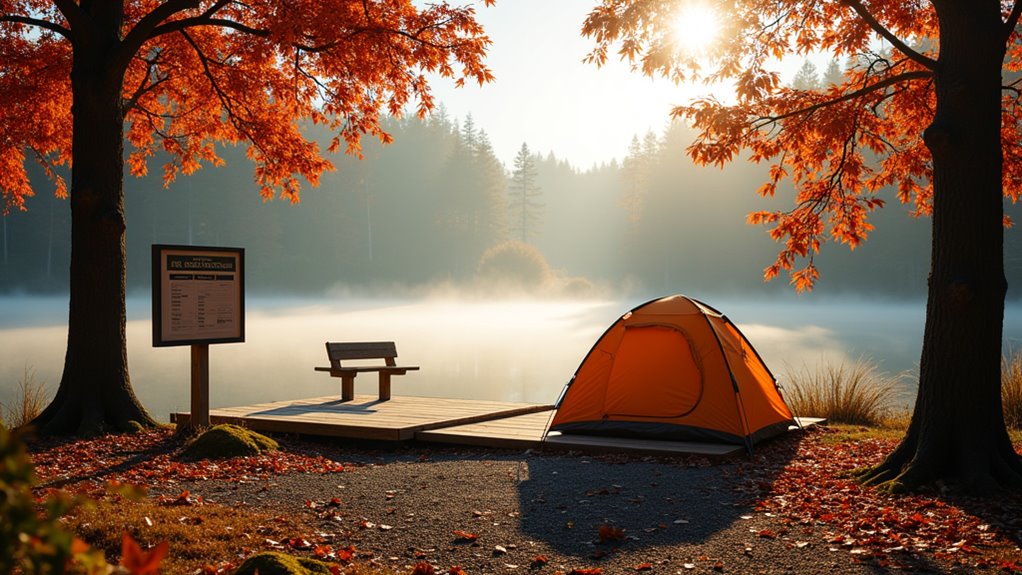
Before planning your fall camping adventure, you’ll need to understand how park operations and accessibility change during autumn months. Many parks reduce their hours, staffing levels, and available services as visitor numbers decline. You should verify if specific facilities like visitor centers or certain amenities will be closed during your intended stay.
Pay close attention to road conditions and trail maintenance, as fall weather can create challenging access issues. While you’ll likely find more available parking and campsites than during peak season, it’s crucial to verify which areas remain open. Consider destinations like Traverse City, Michigan for a unique fall experience with fewer crowds.
Essential camping tips can help ensure a successful trip, even during the off-season. Don’t forget to research emergency services availability, as some parks operate with limited resources during this time. For the safest experience, call ahead to confirm current conditions and operational status of your chosen destination.
Understanding regional climate and elevation factors proves essential when selecting your fall camping destination. Different regions experience unique weather patterns and seasonal changes that’ll directly impact your camping experience. You’ll need to take into account how elevation affects temperature, precipitation, and fall foliage timing to guarantee you’re prepared for your adventure. The Smokies offer peak fall colors from mid-October to early November, making them an excellent choice for autumn camping trips. Essential camping tips for first-time adventurers can also help ensure a successful trip.
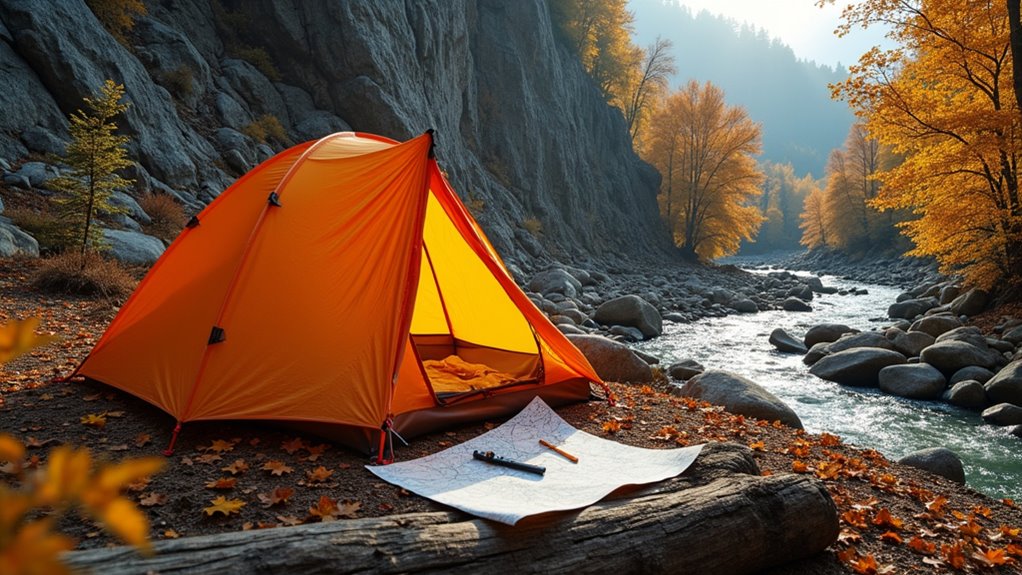
Safety and emergency preparedness form the backbone of a successful fall camping experience, building upon your knowledge of regional climate patterns. When selecting your destination, make sure you’re within reasonable distance of medical facilities, as emergency response times can be critical. Pack thorough first aid kits and reliable communication devices, keeping local emergency numbers readily accessible. Among the 30,000 camping injuries treated annually in emergency rooms, many could have been prevented with proper preparation and proximity to medical care.
Choose campsites away from potential hazards like flood-prone areas and cold air pockets in lower grounds. You’ll need to take into account wildlife risks and establish proper food storage to prevent unwanted animal encounters. Be particularly vigilant about fall-specific risks like hypothermia and changing weather conditions. Before finalizing your location, verify the availability of emergency services and research the area’s specific hazards, including terrain challenges and water safety concerns. Familiarize yourself with common camping injuries and appropriate first aid responses to ensure a safe trip.
Local regulations and permit requirements vary greatly across different camping destinations, so you’ll need to research the specific rules for your chosen location.
Before setting up camp, always research local rules and permits – requirements can differ significantly between destinations.
Many campgrounds have strict guidelines about length of stay, group size, and environmental protection that you’ll need to follow. State health departments are responsible for regulating many camps and establishing safety standards. Embracing timeless frugality can help you navigate these requirements more effectively.
You’ll also need to know the maximum number of people and vehicles allowed at your site.
You’re responsible for following local guidelines, and non-compliance can result in fines or being asked to leave the campground.
Armed with these tips, you’re ready to discover your perfect autumn camping paradise. Like a masterful artist selecting the perfect canvas, choose your destination by carefully weighing foliage timing, weather patterns, and essential amenities. Remember to check local regulations, secure your permits, and book early. With proper planning, you’ll create lasting memories under crisp fall skies surrounded by nature’s vibrant display.